Rappelling 101: The Ultimate Beginner’s Guide to Getting Down

What goes up must come down. In rock climbing, rappelling is one of the most common ways to get down from a single or multi-pitch route. Therefore, rappelling is an essential skill. Conceptually speaking, rappelling is relatively easy to understand. However, mastering it takes time, patience, and many repetitions.
Statistically speaking, rappelling is one of the most dangerous activities in climbing. Accidents happen all time–the majority of which end up being fatal. Therefore, learning the best practices and staying vigilant every time you rappel is critical for the longevity of your climbing.
Keep reading to learn more about the basics of rappelling, along with essential techniques and safety considerations to help keep you and your climbing partner safe while rappelling during your climbing adventures.

‘Don’t worry, Jim. I’ve done this a zillions of times.’
Jim Collins and Tommy Caldwell on El Capitan (from The Push)
What’s Rappelling?
Rappelling, also known as abseiling in some parts of the world, is a technique of lowering oneself down a rope using a rappel device.
For a standard rappel, a climber will secure a climbing rope to a top anchor. If the anchor points utilize hardware, the rope is typically threaded through rappel rings so that the mid-point of the rope is at the top, giving two strands of equal-length rope that run down towards the ground or the next rappel station.
However, you can also build an improvised rappel by wrapping your climbing rope around monolithic anchors (1), such as questionably strong trees or boulders. Improvised setups and other more advanced rappelling techniques, such as an Australian rappel, one-strand rappels, or double-rope rappels, are not straightforward and require proper instruction.
Once you have correctly fixed the rope to the anchor, you can thread the two strands of the climbing rope into a rappelling device.
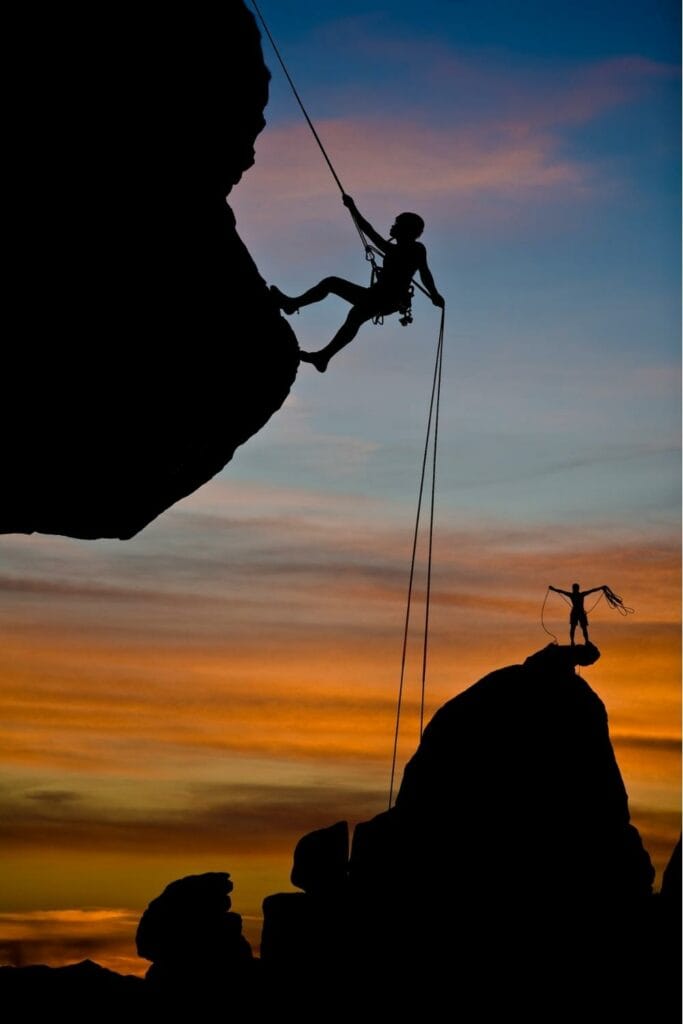
When the rope is properly secured to the rappel device, a rappel backup is normally installed to protect the climber in an emergency.
After the rappel system has been fully built, it’s customary for the entire party of climbers to double-check for errors. Once the newly installed system has been tested and deemed safe, the climber can then begin their descent.
Scenarios Where Rappelling is Necessary
There are many different scenarios when climbers rappel. However, new-school climbing ethics argue that when considering the descent options of a climbing route, you should consider rappelling last due to its dangerous and notorious background.
Nonetheless, there are times when rappelling is the best or only choice to descend a route or accomplish a certain task. Below we will talk about five scenarios where rappelling is frequently the best choice for the descent.

Descending off a climb when lowering or walking off is not an option
Cleaning and being lowered off the climb is the best practice when single-pitch climbing. Lowering is statistically safer than rigging a rappel and should be your go-to choice for getting off single-pitch routes.
For descending from multi-pitch routes or mountaineering routes, it’s safer to walk off the back of the rock formation and back to the base of the climb. However, walking off is not always an option. In which case, the best choice for going down is rappelling.
Getting to the base of a route when there are no other approach trails
Depending on the climbing destination, rappelling may be the only way to get to the start of the climb.
For example, to go sea cliff climbing (2) in the United Kingdom, climbers are used to rappelling (or abseiling) off the top of the cliff to reach the start of the climb down below.
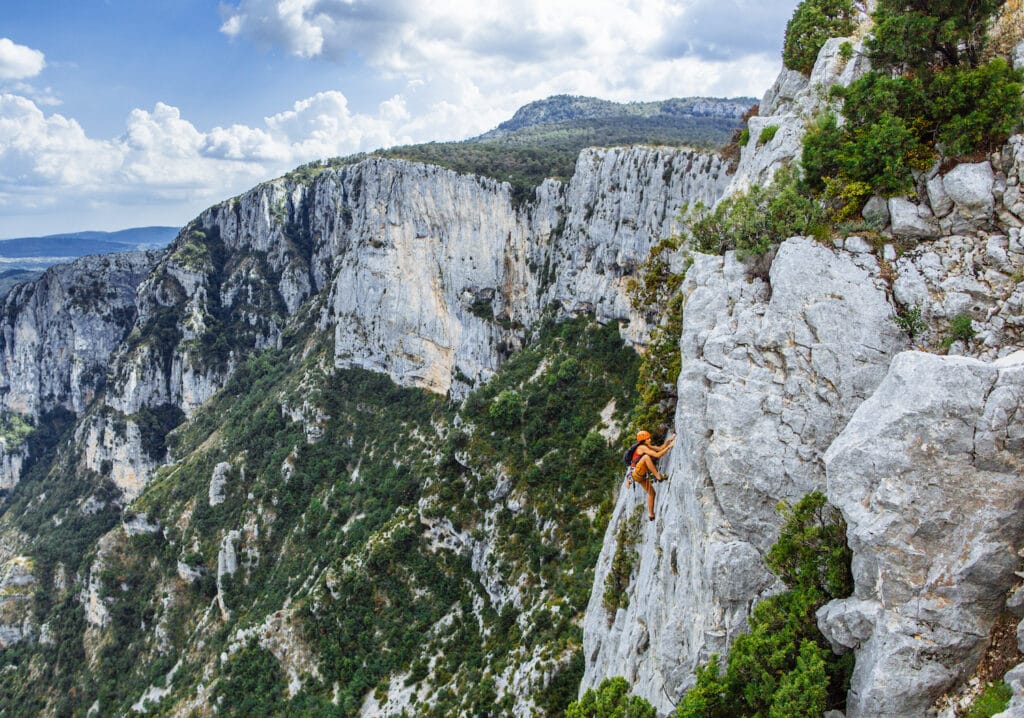
Depending on your route of choice, rappelling to the base of the climb may also be the only way to reach the start of the climb in destinations like the Black Canyon of Gunnison (3) in the United States or the Verdon Gorge (4) in France.
When you want to mitigate wear on the rope (and anchor hardware) after cleaning a single-pitch route
Back in the day, it was common practice to rappel from the top anchor of single-pitch routes after cleaning the route. The reason to rappel instead of lower was to mitigate the wear and tear on the fixed anchors.
However, nowadays, new-school ethics argue on behalf of lowering from single-pitch climbs because it’s statistically much safer. Yes, there is additional wear on the anchor hardware when you lower a climber, but it is much easier to replace climbing hardware than human life.
However, there is something to be said about wanting to mitigate the wear on your climbing rope, specifically in scenarios where sharp rock is involved.
In a scenario where lowering the climber would mean the rope would have to run over a sharp edge of the rock, it may be safer to consider rappelling, so long as the climber is well-versed and possesses all the necessary equipment.
Descending to clean off the loose rock or install new bolts
Rappelling is a common tactic in developing new climbing routes to access them from above. Despite the dangers of rappelling, accessing a new climb from above is often the preferred tactic because it mitigates the risk of overhead hazards–like loose and falling rocks.
Rappelling from above allows a route developer to clean off loose rocks without exposing themselves to dangerous falling objects.
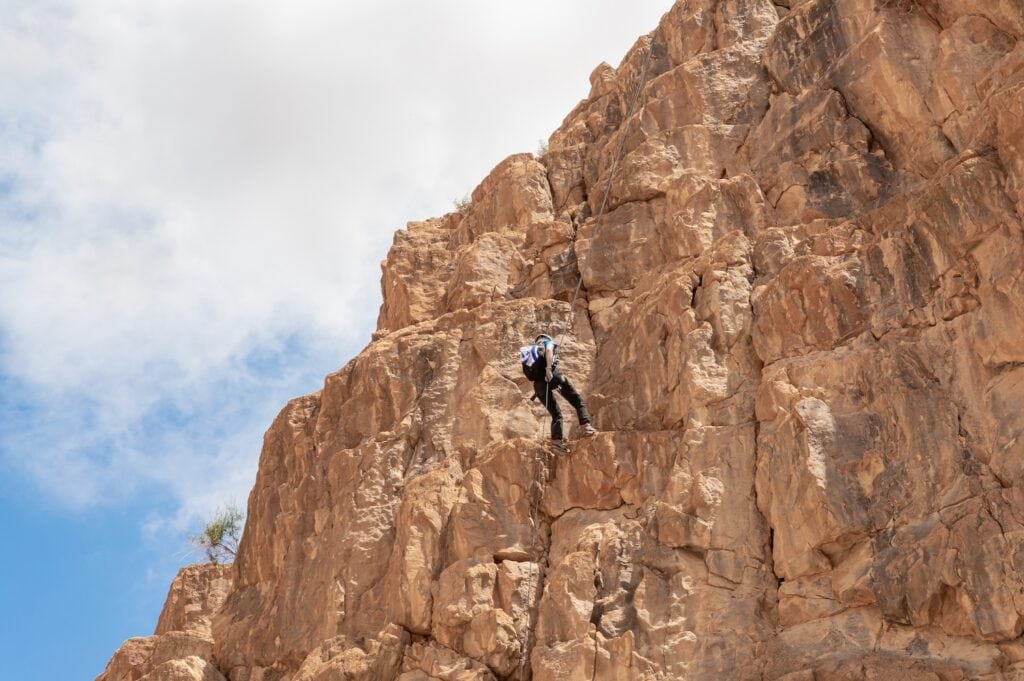
Depending on the local climbing community and climbing ethics, route developers can also install new bolts on a sport climb by rappelling from the top. This tactic removes the necessity to lead the climb from the ground up. For that reason, it’s the preferred technique for developing new climbs that are certain to be extremely technical and difficult.
To access an injured climber from above
In an emergency scenario where someone has become injured or stranded on a rock wall ledge, rappelling is often the fastest way to reach them rather than climbing up from the ground.
However, there are clearly other factors at play in a rescue scenario that may make reaching the injured climber via rappelling impossible.
When you go on a canyoning adventure
Canyoning, or canyoneering (5), is an adventure sport that involves descending down a watercourse (i.e., river, stream, or creek) by utilizing various techniques like rappelling, sliding, jumping, swimming, and climbing.
Required Gear

- Helmet- required for all outdoor climbing.
- Harness- modern harness that fits you well and is double-backed.
- Gloves- are great for protecting your hands and giving you more control.
- Rappel Device – rappel devices are often also used as belay devices.
- Tethering System- sewn slings or personal anchor systems.
- Friction Hitch- sewn hitch cords or custom nylon cords (see prusik knot).
- Locking Carabiners- the more, the merrier.
- Self-Rescue Gear- more important than the gear are the skills to self-rescue
To go further, check out our rappelling gear guide.
Safety Considerations for Rappelling
Rappelling is a dangerous activity. However, with the proper training and equipment, risk while rappelling can be mitigated significantly.
According to the annual report of Accidents in North America Mountaineering (ANAM) (6), there are three primary causes of rappelling accidents.
- Inadequate anchors and catastrophic anchor failure
- Inadequate backup of rappels
- Rapelling off the ends of the ropes due to uneven ropes

Besides these three primary concerns, other less common causes for accidents are issues with the rappel device, getting stranded on the cliff due to inadequate rope length, or harness and belay loop failure.
To address these safety concerns, it’s vital that climbers who are learning to rappel thoroughly review the following safety considerations.
Assessing fixed anchors
Rappel anchors need to be unquestionably strong. To guarantee that the rappel anchor you are utilizing is strong enough to rappel, you need to assess the quality of the anchor.
If the anchor utilizes fixed hardware, like bolts, rappel rings, or chains, we recommend checking the quality of the equipment.
- Are the bolts adequately installed into the rock?
- Is the hardware rusty?
- Are there sharp edges where the rope will run through the hardware?
- Are the quick links screwed shut?
- Are the bolt hangers spinning?
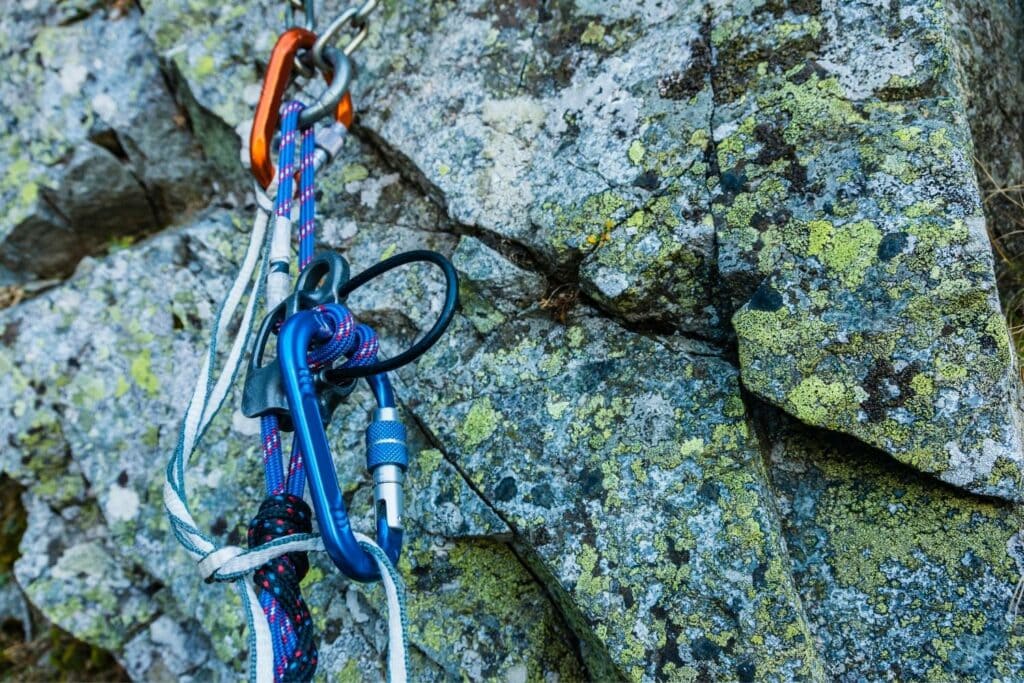
If you are utilizing a monolithic rappel anchor, like a tree or large boulder, we recommend assessing the strength of the anchor.
- Does the tree look dead or alive?
- Does the tree have a robust root system?
- Will the tree or boulder wobble if you try to move it?
- The tree or boulder might have soft goods, for example, webbing, cordelette, or slings wrapped around it with a locking carabiner, quick links, or rappel rings. Do the soft goods look torn or frayed? How does the hardware look?
Taking steps to assess the quality and strength of your rappel anchor should never be forgotten.
Backing up the rappel device
Due to the danger of rappelling, installing a backup on your rappel device is best practice. There are various ways to backup up a rappel. Some of which we will talk about below.
A backup will brake the rappel device for you if you cannot brake yourself– for example, if you lose consciousness due to a rockfall event. A backup will also allow you to go hands-free while you are rappelling, which is an essential ability for cleaning routes or performing a rescue.
Suppose you cannot include a backup directly into the rappel system itself. In that case, you can provide a firemen’s belay from below to better protect the descending climber.
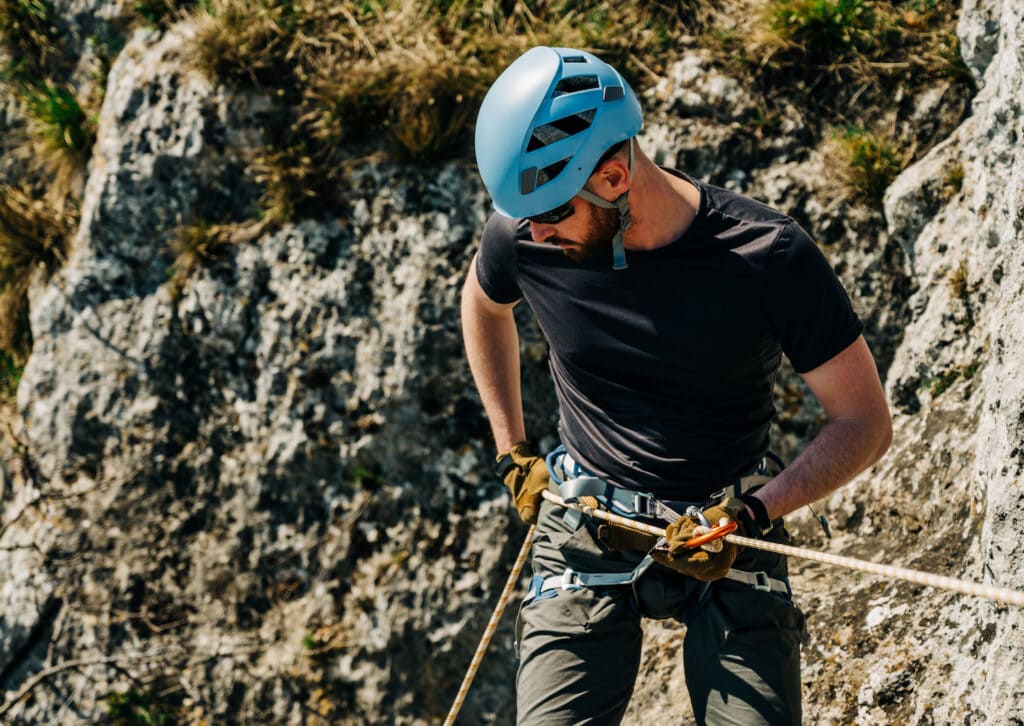
Closing the system
The third primary cause of accidents while rappelling is due to rappelling off the ends of the rope. Typically, this occurs when the ropes are uneven.
To prevent this accident, it is best practice to tie knots in the ends of your ropes. In the event that you rappel to the ends of your rope, a stopper knot in each strand of rope will block you from rappelling off your ropes and falling.
It is worth mentioning that if you tie knots into the ends of your rope, you may increase the chances of your ropes getting stuck in cracks or anchors when you start pulling the ropes. However, many climbers agree that taking this risk is worth it to avoid a more catastrophic accident.
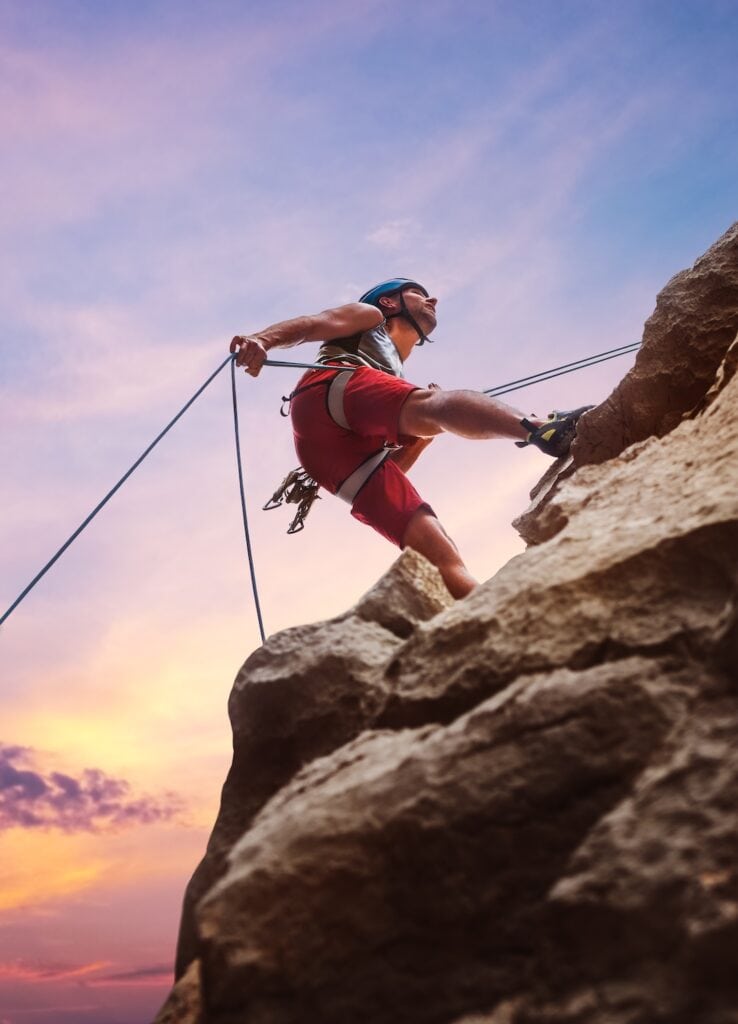
Additional safety considerations
Monitoring where your rope is
As you rappel, monitoring where your rope is above and below you is good practice.
Above, you want to ensure the rope does not run over sharp edges. Down below, you want to ensure your rope is not getting stuck in cracks, chimneys, or trees.
You also want to ensure that when you begin pulling your rope after you rappel, it will not dislodge any loose rocks or fall into rope-eating cracks.
Wearing a helmet
If you are climbing outside, you should always be wearing a helmet. Wearing a helmet while rappelling will better protect you from falling overhead hazards, like loose rocks or even a belay device.
Double checking your system
You should never use your newly installed rappel system without first double-checking. For example, you want to guarantee that the ropes are threaded correctly, that your carabiners are locked and that your backup is functioning properly.
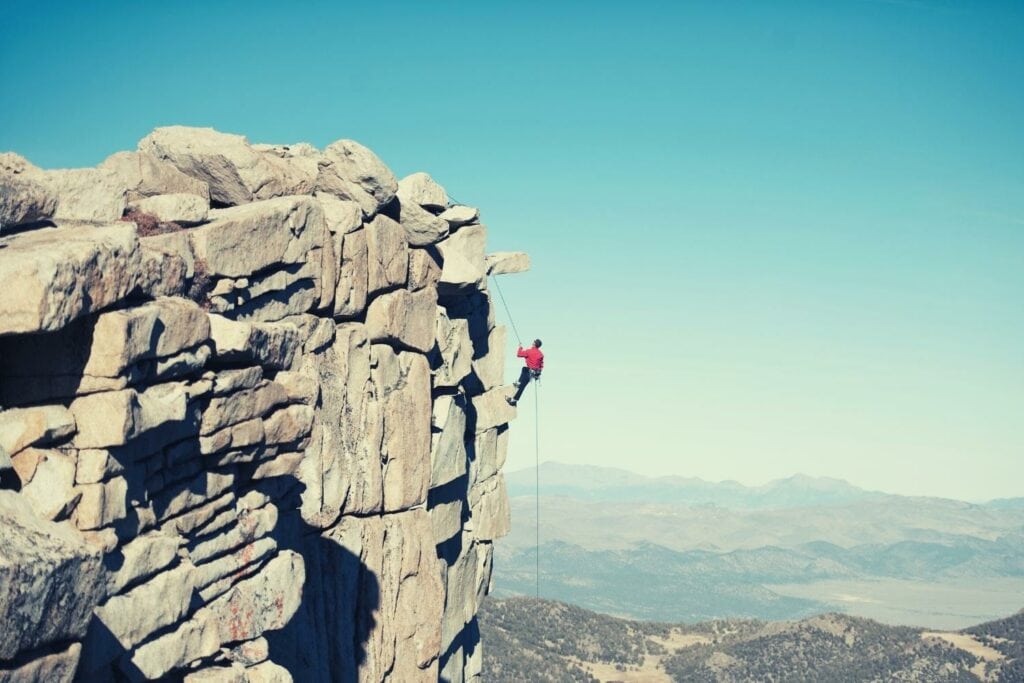
Important Techniques to Learn
Learning to rappel is an important skill in itself. However, some other vital skills and methods are equally as important, if not more important.
Below we will list five essential skills that every climber should know if they want to descend a mountain via a rappel.
Tying knots
Understanding which knots to tie for the given application is critical. For example, knots help close the system, joining two ropes, and rigging your tether.
Extending the rappel
it is best practice to extend your rappel device. Extending your rappel device off the belay loop of your harness gives you more control and allows your fiction hitch backup to function more effectively.
Tying friction hitches
The best way to back up a rappel is to install a friction hitch from your belay loop and onto the ropes below your rappel device.

Ascending the rope
If the rope gets stuck or passes the next rappel station, you may need to ascend the rope using various special techniques and equipment.
Firemen’s belay
If a climber cannot back themselves up with a friction hitch, their partner can go first and provide a firemen’s belay from below to keep them safer.
Check our article Belaying: The Complete Beginner’s Guide for more information on belaying.
Practical Tips to Get Started
Hire a professional guide
one of the best ways to learn new skills is from a professional climbing guide. They will teach you the most modern best practices.
Sign up for rappelling class
Depending on your local climbing community and indoor gym, it may be possible to sign up for a class that teaches rappelling.
Practice on the ground
Mastering the workflow of threading an anchor, setting up your rappel device, and double-checking your system can be accomplished with two feet on the ground.
Final Thoughts About Rappelling
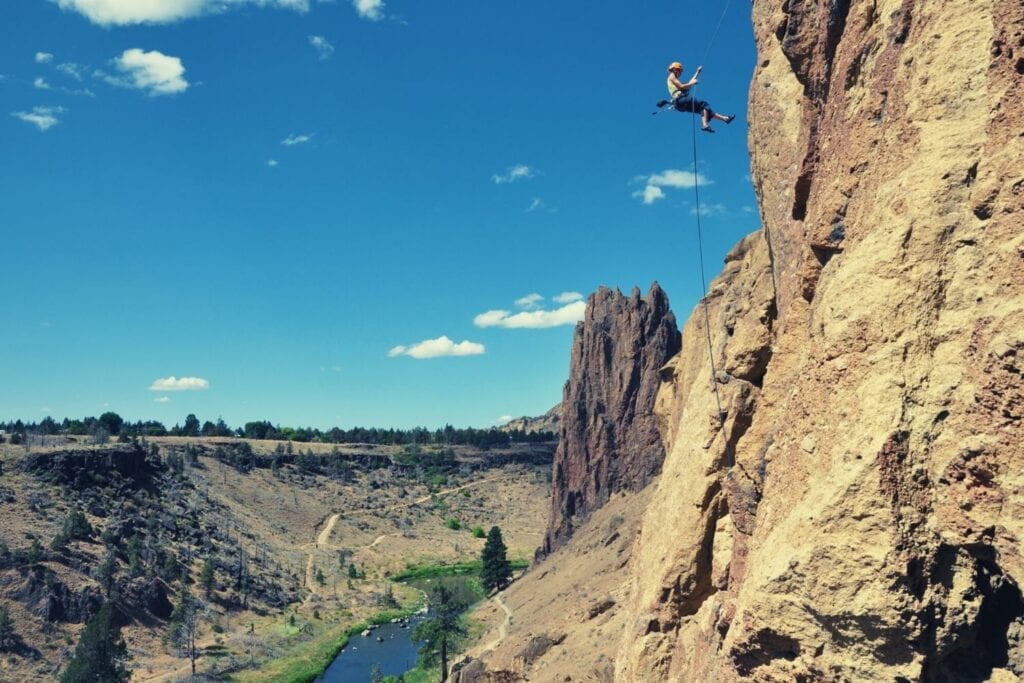
Rappelling is an essential technique for most climbing adventures. Depending on the terrain and scenario, it’s one of the most important skills to get down from a single-pitch cliff, big wall, or mountain.
Learning how to set up a rappel safely goes beyond just reading one article. What we’ve described regarding how to rappel and the gear you need to descend safely is not a complete guide.
It cannot substitute for an actual outdoor climbing experience and the proper instruction. But for many climbers, it’s a great place to learn the basics of rappels before leaving the ground.
Have fun out there. And always remember to double-check your system before you descend.
FAQs
These two terms are used interchangeably to refer to the same thing: lowering down using ropes. It’s common to hear North American climbers talk about rappelling while their European counterparts will use the term abseiling instead.
After reaching the top of their ascent, climbers can either rappel down or hike if there’s a suitable trail. For example, there’s a trail leading to the top of El Cap in Yosemite.
References
Monolith rope anchor (YouTube)
Sea cliff climbing skills – Mountain-Training.org
Black Canyon of The Gunnison – National Park Service
Gorge du Verdon – Official Tourist Office
